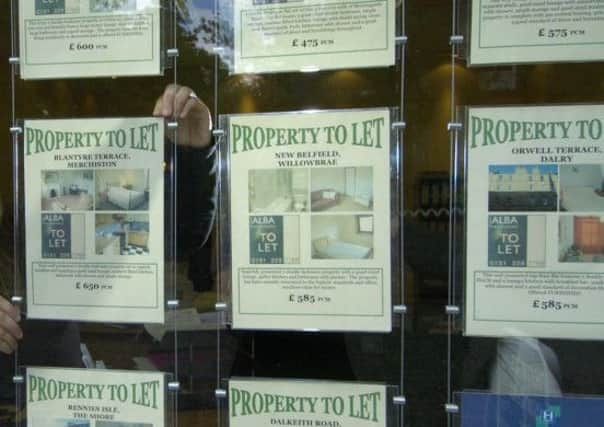Scots renting homes privately ‘double in 20 years’


Research for the Joseph Rowntree Foundation (JRF) showed fewer people in Scotland living in council and housing association homes, with more households now renting their home from a private landlord.
In 2011, just under a quarter (24 per cent) of all households in Scotland were living in social housing, down from 41 per cent in 1991.
Advertisement
Hide AdAdvertisement
Hide AdAt the same time, the proportion of households who are private renters had doubled, from 7 per cent in 1991 to 14 per cent two decades later.
But average private sector rents are 86 per cent higher than the average cost of renting a property in the social housing sector, according to the research by the New Policy Institute.
Tom MacInnes, co-author of the report, said: “Affordable housing, often social housing, has been key to progress in tackling poverty in Scotland.
“As the stock declines, low-income families increasingly find themselves in more expensive, private rented accommodation.
“This undermines the Scottish Government’s hopes of reducing poverty and tackling high living costs.”
‘Poverty no longer predominantly in social housing’
The report said the fall in the number of people in social housing had initially coincided with a rise in the number of people buying their own homes, but added that “more recently growth in private renting has been greater”.
It added: “This has changed the nature of poverty in Scotland. The number of households in poverty in the private rented sector (PRS) has doubled in the last decade to 120,000, while the number in social housing has almost halved to 190,000.”
The report went on: “At the start of the 2000s, poverty in Scotland was predominantly in the social rented sector but this is no longer the case.
Advertisement
Hide AdAdvertisement
Hide Ad“Two-fifths of households in poverty live in social housing, compared to three-fifths a decade ago. Meanwhile a quarter live in the PRS, up from one in 10.
“Whilst the overall poverty rate has fallen in Scotland over the last decade, the rate for private rented households (36 per cent) has not.”
Jim McCormick, Scotland adviser to JRF, warned that a failure to act on these “stark” figures would see poverty rates in Scotland rise.
He said: “The focus of debate on housing during the referendum campaign has been dominated by the under-occupancy charge (the so-called ‘bedroom tax’).
“While there have been significant steps to mitigate its impact, both sides must not lose sight of another trend: more families facing higher housing costs and rising levels of poverty in private rented homes.
“Whatever the outcome, failing to act on these stark figures will see Scotland’s poverty rate rise.”
Graeme Brown, director of the housing charity Shelter Scotland, said: “This report shows clearly that Scotland’s chronic shortage of social housing is forcing more and more people on lower incomes into the private rented sector, people who in the past would have enjoyed the safety and security of social housing at an affordable rent.”
Poverty ‘down compared to rest of UK’
Meanwhile, separate research carried out by the University of Glasgow and funded by the JRF revealed how poverty in Scotland had fallen in comparison with the rest of the UK.
Advertisement
Hide AdAdvertisement
Hide AdThe study, by Nick Bailey, a senior lecturer in urban studies, suggests lower housing costs in Scotland, together with a better performance from the labour market, are the most likely factors behind the fall.
Mr Bailey said: “The reduction in Scotland’s poverty rate is modest and comes at a time of great hardship for many families. Even so, it represents a real improvement and an historic break.
“One factor is housing costs - an area where the Scottish Government can have great influence. It needs to ensure that it makes affordability of rents and mortgages a central aim of anti-poverty policy in future.”
A Scottish Government spokeswoman said: “We welcome the report highlighting poverty rates in Scotland being lower than the rest of the UK .
“We are doing everything within our limited powers to tackle poverty and combat the detrimental effect of Westminster’s welfare reform.
“We have committed to deliver 30,000 affordable homes during this Parliament, at least 20,000 of those will be for social rent, and we have put in place the funding - over £1.3 billion in the four years to March 2016 - to make that happen.”
She added that the Scottish Government was to speed up plans to end the right-to-buy for tenants in council and housing association properties, so this would be ended two years after the legislation - which is currently going through Holyrood - gets Royal Assent.
The spokeswoman said this would “ensure that an additional 15,500 social homes are available for rent over a ten-year period and safeguard social housing stock for future generations.”
Advertisement
Hide AdAdvertisement
Hide AdShe stated: “With 155,000 people on local authority and common waiting lists for social rented houses, we can no longer afford to see the social sector lose out on badly-needed homes.
“We are doing all we can but it is only with the full powers of independence that we will be able to get more households out of poverty.”
SEE ALSO: